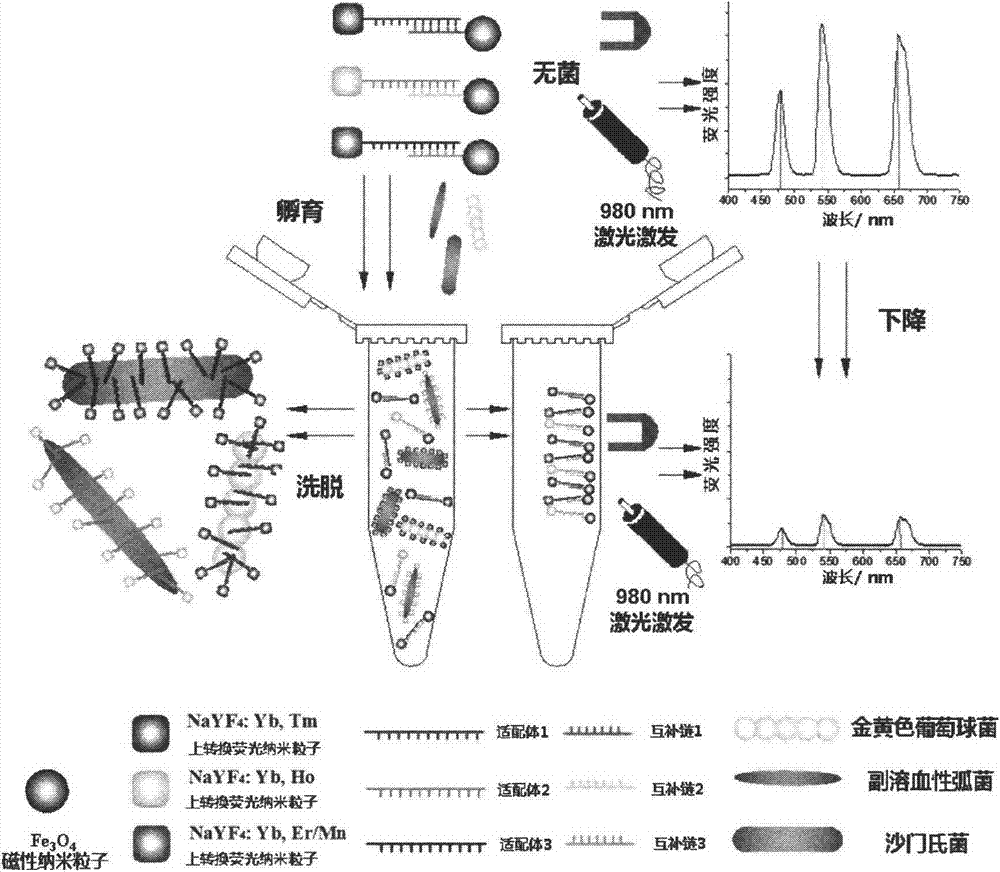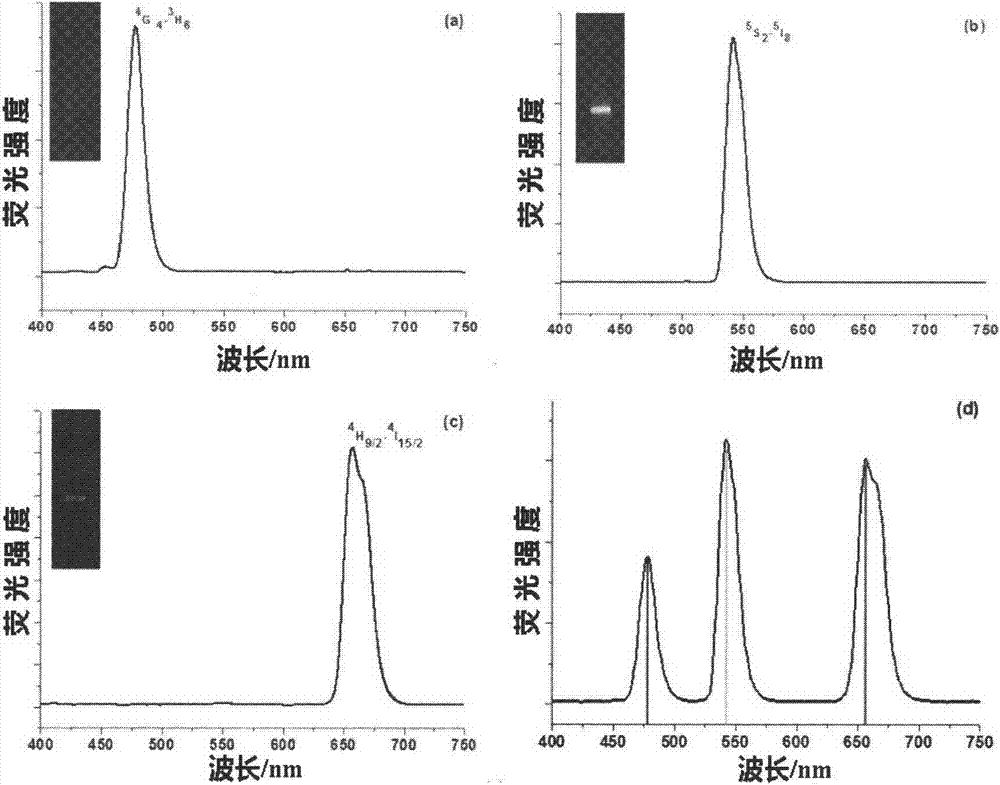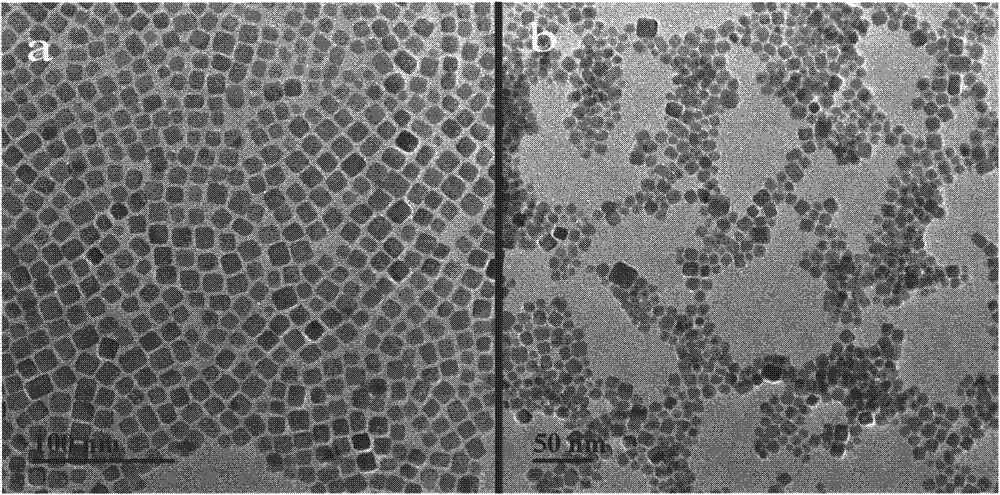Method used for simultaneous detection of three food-borne pathogenic bacteria based on multicolor upconversion fluorescence labeling
A food-borne pathogenic bacteria, fluorescent labeling technology, applied in the field of nanomaterials and analytical chemistry, can solve the problems of high fluorescence background value, unstable nature, influence of detection sensitivity, etc., to improve sensitivity, accuracy and stability Effect
- Summary
- Abstract
- Description
- Claims
- Application Information
AI Technical Summary
Problems solved by technology
Method used
Image
Examples
Embodiment 1
[0024] Embodiment 1: the establishment of standard detection curve of Staphylococcus aureus, Vibrio parahaemolyticus and Salmonella
[0025] Take 200 μL of upconverting fluorescent nanoparticles functionalized by aptamers of three kinds of pathogenic bacteria, and incubate with magnetic nanoparticles modified by corresponding complementary strands at 37°C for half an hour, and form three pairs of upconversion through base complementation—magnetic bead nanoparticle Complex. The unbound upconversion nanoparticles were washed away by magnetic field separation, and the upconversion fluorescence intensities at 477nm, 550nm and 660nm were recorded by excitation with a 980nm light source. Subsequently, three pathogenic bacteria were added at different concentrations ranging from 1 cfu / mL to 1 × 10 8 cfumL. Incubate at 37°C for another half an hour, wash off the fallen upconversion nanoparticles after magnetic field separation, measure the fluorescence intensity of the remaining nan...
Embodiment 2
[0029] Example 2: Simultaneous detection of three pathogenic bacteria in actual milk samples
[0030] Purchase 4 kinds of aseptic milk from the local supermarket, and add the concentration range of 1×10 2 cfu / mL to 1×10 5 cfu / mL of the three pathogenic bacteria. Take 5mL of milk and centrifuge at 7000 rpm for 10 minutes at 10°C, remove the upper layer of milk fat, and then dilute it by 20 times. Utilize this discovery method to detect the concentration of three kinds of pathogenic bacteria in milk. The method is similar to Example 1. Record the up-converted fluorescence intensities at 477nm, 550nm and 660nm three places excited by 980nm, and use the linear equation of pathogenic bacteria and fluorescence intensity to get The concentration of three pathogenic bacteria, the results are shown in the following table:
[0031] Table 2: Detection results of three pathogenic bacteria in actual milk samples
[0032]
[0033] It shows that the present invention can be applied to...
Embodiment 3
[0034] Embodiment 3: Simultaneous detection of three kinds of pathogenic bacteria in the actual sample of shrimp meat
[0035] Purchase 4 kinds of frozen shrimp meat from the local supermarket. After thawing, weigh 25g of shrimp meat and soak them in 225mL alkaline peptone containing 3% NaCl, and add the concentration range of 1×10 2 cfu / mL to 1×10 5 cfu / mL of the three pathogenic bacteria were mixed evenly. Centrifuge the sample after resting for 30 minutes, filter the supernatant with ultra-fine glass fiber filter paper, and collect the filtrate for later use. Utilize this discovery method to detect three kinds of pathogenic bacteria concentration methods in shrimp meat similar to embodiment 1, record the up-conversion fluorescence intensity at 477nm, 550nm and 660nm three places that 980nm excites and obtain, utilize the linear equation of pathogenic bacteria and fluorescence intensity, Obtain the concentration of three kinds of pathogenic bacteria, the results are shown ...
PUM
 Login to View More
Login to View More Abstract
Description
Claims
Application Information
 Login to View More
Login to View More - R&D
- Intellectual Property
- Life Sciences
- Materials
- Tech Scout
- Unparalleled Data Quality
- Higher Quality Content
- 60% Fewer Hallucinations
Browse by: Latest US Patents, China's latest patents, Technical Efficacy Thesaurus, Application Domain, Technology Topic, Popular Technical Reports.
© 2025 PatSnap. All rights reserved.Legal|Privacy policy|Modern Slavery Act Transparency Statement|Sitemap|About US| Contact US: help@patsnap.com



